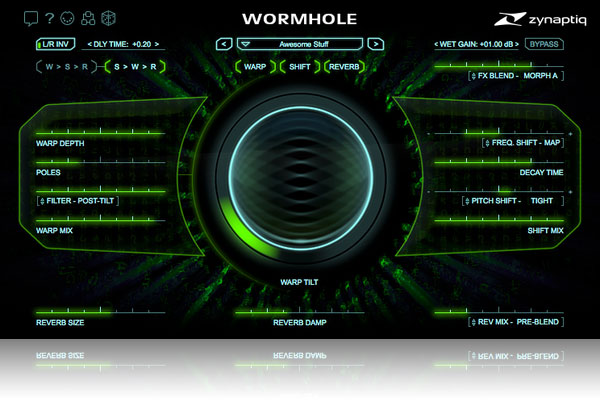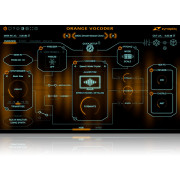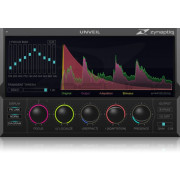You're currently on:

Otherworldly Audio Effects
From beautifully shimmering detuned guitar widening and glassy ambient octave-shift tails, to surreal ambiences, starship drones, alien, monster, and robot voices — WORMHOLE is the new indispensable multi-effects powerhouse for sound designers, music producers and film composers alike. Combining ultra-clean pitch/frequency shifting, eccentric spectral warping, dual lush reverbs, and unique dry/wet morphing, WORMHOLE delivers sounds so unearthly you’ll swear they’re from a parallel universe.
The key WORMHOLE features at a glance:
High-quality multieffects processing ranging from the sublime to the extreme.
WARP spectral inversion & warping module.
SHIFT unique topology combined pitch-/frequency-shifting module with SMOOTH, TIGHT and two DETUNE modes.
Dual lush randomized hall reverbs.
Unique dry/wet morphing.
Very wide +- 4 octaves pitch-shift and +-4000Hz frequency shift range, fully aliasing free, with 96dB/oct(!!) carrier and side-band attenuation.

Powerhouse
WORMHOLE consists of 5 highly synergistic processing modules: the spectral WARP, the pitch/frequency SHIFT, the dual random modulated hall REVERB, a nifty little DELAY, and the dry/wet morphing FX BLEND sections. In combination with a flexible signal path, this makes WORMHOLE an ultra-fast and easy-to-use, high-end multieffects processor, that covers the full range from the subtle to the (very) extreme. Whether you're a sound designer, music producer or ambient artist, WORMHOLE is for you.
So What Is This For?
While WORMHOLE excels at making the usually time-consuming workflows of creating high-quality Sci-Fi sounds and creature voices fast, easy, fun and extremely hi-fi, it actually covers a very broad range of applications – including musical sweetening and ambient effects from the grungy to the shimmering and lush, bread-and-butter mixing effects like creating suboctaves, widening, chorusing, filtering, harmonic shaping and reverberation, and some seriously psychedelic electronica colors and mangling effects. Here are some of the things WORMHOLE is great at.
Alien, Robot and Monster Voices & Space-Age Transmission FX
WORMHOLE is insanely good for making all sorts of creature and robotic voices, as well as making them sound like the gravitometric faster-than-light transceiver went out-of-range. The WARP and SHIFT sections provide the mangling, while the dry/wet morphing ensures intelligibility (even with extreme transformations) and serves to fine-tune the alienification amount – reigning even the strongest processing back in if so desired. Or use the morphing to gradually transition from clean to mutated in an otherwise impossible, cool way.
Surreal Soundscapes and SFX
With WORMHOLE, spaceship atmospheres and neutrino accelerator field fluctuation induced interference oscillations are unbelievably easy to make – and sound unbelievably good, too. Turn cute metal clangs into huge impacts of intergalactic proportions, aircondition rumble into ancient planetoid displacement machinery hum, and synthesizer waveforms into mutated cyborg production facility power plant drones. Then, animate the sound organically by moving the dry/wet morph and section dry/wet mixes just a little bit. Or go crazy and automate everything all over the place, of course.
Musical Effects – Shimmering, Ambient, Lush, Beautiful
Guitars, pianos, pads all love WORMHOLE. It does just that thing that you'd typically reach for your really awesome vintage rack multi-effects units for, and feed them back into each other through the console...if they weren't out for service. Again. With unknown ETA due to the parts being unobtainium. And actually, WORMHOLE is the space-age version of that approach. No pitch-shifter induced disharmonic sidebands or graininess. Just pure, lushly blissfull glassy ambient fifths and octaves, micro-detuning shimmers, and more. Did we mention the dual, cascadable random modulated hall reverbs yet?
Mixing Effects – Widening, Chorusing & More
Since we gave WORMHOLE a really great pitch shifter, we figured: it would be smart to also make it do the L/R Detuning-Widening-Chorusing Thing. As we try to be smart as much as we can, we taught WORMHOLE how to do just that. The pitch-shifter has two dedicated L/R detuning modes and, taking the approach up another notch, we also created what we believe to be the first center-balanced widening delay. Together with the dry/wet morphing and the dual reverb engines, this makes for organic sounds from the sublimely subtle to the...well, NOT-so-subtle-at-all.
Far-Out Electronic Musical Effects & Destruction
Create sounds that mimic oscillator sync using any sound as the source. Even after the fact. Apply super-high fidelity frequency shifting, create wild pumping textures that sound far more aggressive than possible with a compressor, use the WARP circuit for emulating sample rate reduction and for creating unique lo-fi tones in a hi-fi way. Or, more generally speaking: transform your sounds in otherworldly ways. That's WORMHOLE. If you dig modular synths (like we do), you'll love it.

Simplexity
None of this complexity translates into your workflow, though – the WORMHOLE user interface is strikingly simple, and the plug-in is a breeze to use. A huge selection of meticulously crafted factory presets and a weighted randomization feature make exploring space beyond the WORMHOLE superluminally fast. Easy to use MIDI Learn for all controls makes fine-tuning parameters easier than translocating into a parallel universe. Well, quite a bit easier, actually. Give the free trial a spin to experience this multi-dimensional joyride for yourself!

Dry-Wet Morphing, a.k.a. FX BLEND
When strongly processing sounds, a simple dry/wet crossfade often fails to do what you really want to achieve – dialling back the intensity of the effect. Instead, you'll get the impression of two sounds playing at once. This is why where other plugins have a dry-wet control, WORMHOLE has FX BLEND. The FX BLEND module expands on the dry-wet concept by providing multiple algorithms for combining the two streams. In addition to the classic d/w crossfade, it features two implementations of our unique structural audio morphing technology to morph seamlessly between your input and the effect. This fuses the two – turning them into one single sound in-between – and can "wrap" the effect signal into the "silhouette" of the source for greater definition aka "tightness" than you typically get from heavy processing. The dry-wet morphing also allows for much greater "realism" on heavily processed sounds such as monster voices, for myriad hybrid sounds to be explored, and for creating super-smooth transitions where the effect harmonics "grow out of the source" in a way you've never heard before.

WARP
WARP performs a unique localized time-domain spectral warping effect, whose flavor lies somewhere between ring- and frequency-modulation, frequency- and formant-shifting, modal resonation, and spectral mapping. WARP sounds mesmerisingly strange and always stays crisp, intelligible, and tight (unless you don't want that, of course). It even includes a mode that introduces discontinuity artifacts to generate grit for all sorts of space-age special effects.

SHIFT
SHIFT combines +- 4 octaves of pitch-shift with +-4kHz of frequency-shift into one single processing step.
The PITCH SHIFTER is a unique design that is neither delay/grain nor FFT/phase-vocoder based. As a result, it exhibits none of the typical artifacts like grains, flamming, or aliasing, and is very low on pitch-jumping or warbling. It features 4 dedicated algorithm modes: SMOOTH, TIGHT, DETUNE A, and DETUNE B. SMOOTH and TIGHT do exactly what their names imply – shifting up or down by up to 48 semitones. The DETUNE modes shift the left and right channels in opposite directions by +- 48 cents for that micro-shifting-chorus-that-is-no-chorus thickening effect. And we're proud to be able to say that WORMHOLE's PITCH SHIFTER sounds incredibly detailed, organic, and warm.
WORMHOLE's FREQUENCY SHIFTER is extremely clean, sporting around 96dB of carrier/side-band suppression, greatly enhancing the useful range of effects achievable. Like the PITCH SHIFTER, the FREQUENCY SHIFTER is fully aliasing-free.
The SHIFT section also features a unique DECAY TIME control. By discarding signal components that exceed an adjustable duration, it unclutters and tightens up the sound in a very cool way. And, when shifting up, it greatly reduces the "ringing" effect caused by the naturally longer decay times of low frequencies being shifted into the subjectively louder mid-range. It can also be used for special effects like simulating analog communications circuit "sagging", or adding timbral "fluttering".

REVERB
What's better than a great reverb? Exactly, TWO great reverbs, of course. That's why WORMHOLE's REVERB section features two simple but super-lush sounding random modulated hall type reverbs with shared controls. One is placed before the FX BLEND – giving effects that aren't quite your typical reverb when used with the dry-wet morphing. The other is placed after the FX BLEND. For maximum reverberation flexibility, you can use either one, or both at the same time.

DELAY
Living in the slot where other plugins have a pre-delay, WORMHOLE's very simple but highly effective DELAY represents an evolution of this concept. In addition to delaying the effect signal, it can delay the dry signal instead...or do both, in opposing directions for the L and R channels. This creates super-wide effects that are still fully balanced around the center of the sound stage. Within seconds. In combination with the pitch shifter's DETUNE modes and the dry-wet morphing (where the DELAY effectively modifies what gets morphed into what), unique sounds ranging from subliminal enhancement to the off-the-hook variety can be created.
On WORMHOLE's WARP, Ring Modulators and Frequency Shifters
WORMHOLE features a WARP and a SHIFT section. WARP performs a proprietary time-domain local spectrum inversion ("frequency warping"). This effect is remotely similar to ring modulators and frequency shifters in that it can produce inharmonic, metallic spectra. It is however a different algorithm that produces timbres that can not be achieved with either – providing a unique new sound to your palette. The SHIFT section combines pitch- and frequency-shifting into one unique process that is completely aliasing-free and features near-perfect side-band and carrier suppression.
To illustrate the differences between the WARP module and the more traditional ring modulation and frequency shifting effects – and to show the high quality of WORMHOLE's frequency shifter design – here is a series of spectrograms made by passing test signals through the various processor types with varying settings.
Ring Modulation
When an audio signal passes through a ring modulator, two so-called "side bands" are generated. These are copies of the input signal, linearly shifted in frequency by the frequency of the modulating oscillator symmetrically in both directions. Here, we used a ring modulator modulator frequency of around 300Hz, using a sine wave sweeping linearly from 160Hz to 2900Hz over a duration of around 2.3 seconds as input (first image). You can clearly see the two side bands in the second illustration (green lines, the red line shows the input signal and is overlaid for illustrational purposes only). As the two side bands are shifted linearly in frequency and harmonics in natural sounds are logarithmically distributed, a "metallic" or "hollow" unnatural sound is created – which can be used to great effect for processing voice.

Test Signal: Sine Sweep

Ring Modulator
Frequency Shifting
A frequency shifter is essentially a ring modulator where one of the two side bands is suppressed, so that the signal is shifted in one direction only. This makes for an effect that takes up much less space in a mix than what you'd get with ring modulation. In practice, the amount of side-band and carrier suppression achieved varies between designs, in most cases it remains audible. This can be seen in the spectrogram below, where we used a well-known plug-in to shift frequency up by the same approximate 300Hz as in the ring modulator example above – the lower sideband is somewhat attenuated but still there.

Frequency Shifter, Upward Shift
Sufficient side-band suppression is, however, critical to achieving high quality frequency shifting and, more importantly, consistently useful results when shifting strongly. With signals that are of higher complexity than a sine-wave, this becomes even more true. Here, we have passed two swept sine-waves through the same well-known 3rd party frequency shifter, shifting down by 500 Hz. As you can see in the second image, the upper side-band is insufficiently suppressed, yielding a rather unclean result. Also note the lower of the two sine-waves appearing invertedly at the beginning of the sweep, this is due to the signal being shifted to below zero Hz and being "reflected" back up, a.k.a. aliasing. Both artifacts are displayed in orange for visibility.


With three swept sines – which is still a very simple signal compared to, for example, a voice – the problem gets worse. The below spectrograms show three swept sines, as well as the same three sines shifted by + 2000 Hz using the same 3rd party algorithm.


WORMHOLE's Frequency Shifter
In comparison, WORMHOLE's frequency shifter is free of any aliasing, and has near-perfect side-band suppression, as evidenced by the spectrograms below – note the complete absence of the unwanted sidebands. Basically, the attenuation of the side-bands is so high that they fall outside of the spectrogram's displayed dynamics range. Audio-wise, this translates into a significantly cleaner sound and a much broader range of useful settings.


WORMHOLE's WARP
WORMHOLE's WARP module behaves somewhat differently. The spectrograms below show the same sine sweep processed with a WARP DEPTH setting of 25%, 50%, 75% and 100%. Note how the structure of the output signal is noticeably more complex than with simple ring modulation or frequency shifting, while at the same time being much more "tidy" and sporting a more balanced distribution. The output is also free of any aliasing. Also note how the output components converge around the input signal with rising values for warp, resulting in a very defined, yet strongly processed sounding sound.

WORMHOLE, 25% Warp

WORMHOLE, 50% Warp

WORMHOLE, 75% Warp

WORMHOLE, 100% Warp
By raising the POLES parameter, this convergence around the original signal's coordinates can be further increased, while at the same time introducing a series of resonance points, which tend to enforce the perception of a specific pitch, and which have sonic characteristics similar to a modal resonator, but with much less time-smearing. The below images illustrate this effect.

WORMHOLE, 100% Warp, 50% Poles

WORMHOLE, 100% Warp, 100% Poles
Finally, the TILT parameter applies processing somewhat similar to an unusually designed pitch/formant shifter – it shifts pronounced spectral features up or down. For simple input material the design of this circuit results in pitch-shift like effects, as can be seen in the below spectrograms, where the signal is rotated vertically (in frequency), while also moving up or down slightly. Note how TILT shows some aliasing coming in from the "top". TILT is intentionally designed to create grit for more extreme sounds.

WORMHOLE, 100% Warp, 100% Poles, -100% Tilt

WORMHOLE, 100% Warp, 0% Poles, +100% Tilt
Formats
WORMHOLE is available for a variety of formats.
On MacOS X:
Apple AudioUnits (32/64bit)
Avid RTAS
Avid AAX Native including AudioSuite (32/64bit)
Steinberg VST 2.4 (32/64bit)
Steinberg VST 3 (32/64bit)
On Windows:
Avid RTAS
Avid AAX Native including AudioSuite (32/64bit)
Steinberg VST 2.4 (32/64bit)
Steinberg VST 3 (32/64bit)
System Requirements Mac
OSX 10.8.x or newer
Intel CPU with at least 2 Cores
Apple AU (AudioUnits), Steinberg VST 2.4, Steinberg VST 3 or Avid RTAS/AAX compatible Host software
For AAX Native 32-bit, the minimum required Pro Tools version is 10.3.6
iLok.com account for machine- or iLok 2 based activation (of full as well as demo versions)
Internet Connection for Software Activation (though not necessarily on the computer used for audio)
System Requirements Windows
CPU with at least 2 Cores
Steinberg VST 2.4, Steinberg VST 3 or Avid RTAS/AAX compatible Host software
For AAX Native 32-bit, the minimum required Pro Tools version is 10.3.6
iLok.com account for machine- or iLok 2 based activation (of full as well as demo versions)
Internet Connection for Software Activation (though not necessarily on the computer used for audio)
Copy Protection
WORMHOLE uses the latest PACE copy protection, which allows you to place your activation on your machine or on an iLok 2* (not included). You will need a free iLok.com account to use our software, including the demos – but you do not necessarily need the iLok 2 dongle, if your machine has internet access. All required software is installed along with our plugins, but we generally recommend downloading the latest versions directly from iLok.com.
*Please note: the older, first generation (blue) iLok is not supported!























